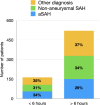Multicentre study of the role of lumbar puncture in the diagnosis of spontaneous subarachnoid haemorrhage
- PMID: 40676358
- PMCID: PMC12270960
- DOI: 10.1007/s00701-025-06602-8
Multicentre study of the role of lumbar puncture in the diagnosis of spontaneous subarachnoid haemorrhage
Erratum in
-
Correction to: Multicentre study of the role of lumbar puncture in the diagnosis of spontaneous subarachnoid haemorrhage.Acta Neurochir (Wien). 2025 Jul 31;167(1):210. doi: 10.1007/s00701-025-06630-4. Acta Neurochir (Wien). 2025. PMID: 40742480 Free PMC article. No abstract available.
Abstract
Objectives: This study identified the proportion of spontaneous subarachnoid haemorrhage (SAH) patients diagnosed by Lumbar Puncture (LP). Furthermore reporting the incidence of aneurysmal SAH if a CT scan performed within 6 h was reported as negative, and finally investigated if there has been a change in practice since the new NICE guidance for the diagnosis of SAH was published in November 2022.
Methods: A pragmatic multicentre audit was conducted in the UK and Ireland capturing referrals to 25 Neurosurgical centres between 1st November 2020-31st October 2023. Case referral identification was done in each unit using local medical records and referral databases based on local protocols.
Results: 10,187 cases of spontaneous SAH were diagnosed within the study period: 9,357 were diagnosed by CT and 717 by LP. 7% of all confirmed SAH cases underwent lumbar punctures to return a diagnosis of spontaneous SAH when a CT head scan was non-diagnostic. This yielded 213 (3%) diagnoses of aneurysmal SAH. 55 cases(1%) of aneurysmal SAH initially had negative CT head scans within 6 h of ictus and a positive LP. We did not identify any evidence of a change in practice following the introduction of the NICE guidance in November 2022.
Conclusion: This study shows that LP continues to be an important diagnostic test that will confirm a diagnosis of aneurysmal SAH in a small, but significant number of patients with thunderclap headache. We provide new data that may impact the current NICE guidelines on the diagnosis of SAH.
Keywords: Cerebral aneurysm; Lumbar puncture; Subarachnoid haemorrhage.
© 2025. The Author(s).
Conflict of interest statement
Declarations. Consent to participate: This project was conducted as a multicentre audit of fully anonymised clinical records. Individual informed consent was not required, as no patient-identifiable information was collected or reported and the study involved only existing data gathered during routine care. Ethical approval: This study was categorized as an audit and therefore did not require formal ethical approval from an ethics reviews board according to the NHS Health Research Authority. This is in line with: • UK Policy Framework for Health and Social Care Research (2017), Section 2.4 (use of existing anonymised data). • HRA guidance on distinguishing audit/service evaluation from research requiring consent. Competing interests: The authors declare no competing interests.
Figures
References
-
- Backes D, Rinkel GJE, Kemperman H, Linn FHH, Vergouwen MDI (2012) Time-dependent test characteristics of head computed tomography in patients suspected of Nontraumatic subarachnoid hemorrhage. Stroke 43(8):2115–2119 - PubMed
-
- Chakraborty T, Daneshmand A, Lanzino G, Hocker S (2020) CT-negative subarachnoid hemorrhage in the first six hours. J Stroke Cerebrovasc Dis 29(12):105300 - PubMed
-
- Cortnum S, Sorensen P, Jorgensen J (2010) Determining the sensitivity of computed tomography scanning in early detection of subarachnoid hemorrhage. Neurosurgery 66(5):900–2; discussion 3 - PubMed
-
- Cruickshank A, Auld P, Beetham R, Burrows G, Egner W, Holbrook I et al (2008) Revised national guidelines for analysis of cerebrospinal fluid for bilirubin in suspected subarachnoid haemorrhage. Ann Clin Biochem 45(Pt 3):238–244 - PubMed
-
- Dubosh NM, Bellolio MF, Rabinstein AA, Edlow JA (2016) Sensitivity of early brain computed tomography to exclude aneurysmal subarachnoid hemorrhage: a systematic review and meta-analysis. Stroke 47(3):750–755 - PubMed
Publication types
MeSH terms
LinkOut - more resources
Full Text Sources



